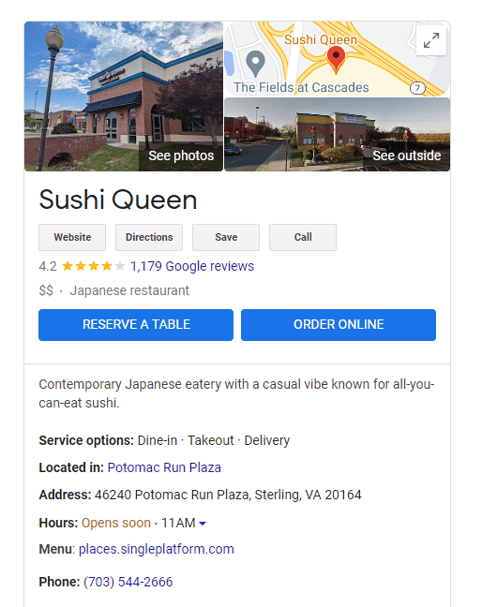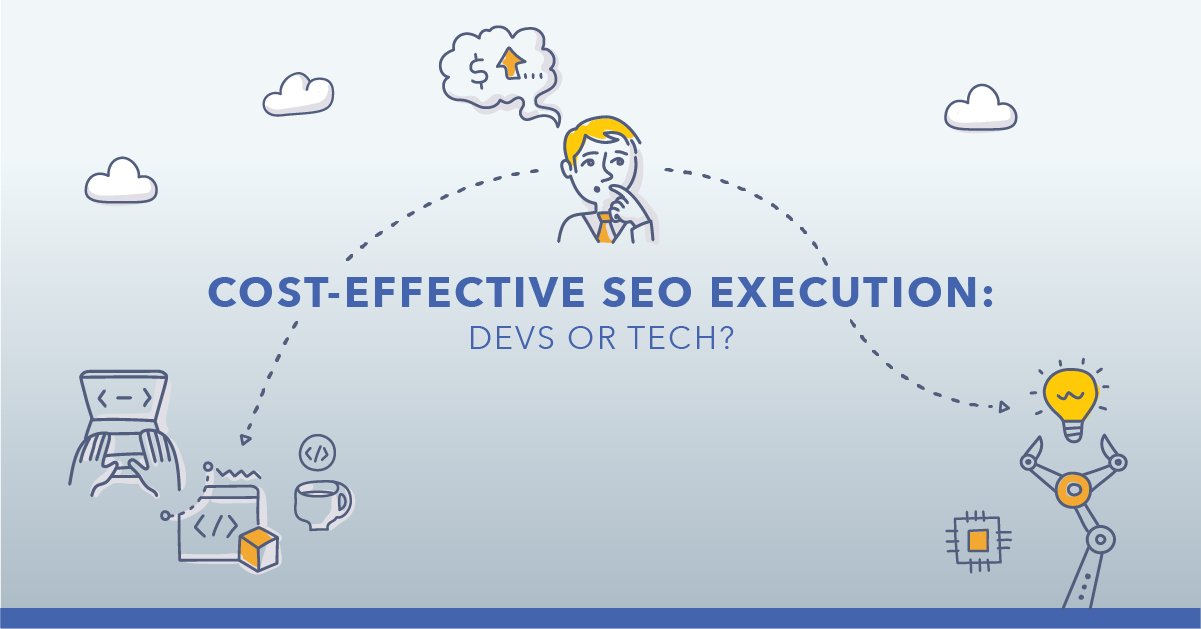There is tremendous opportunity when it comes to local SEO: only 5% of companies follow best practices in their Google Business Profile (formerly known as a Google My Business account).
That statistic comes from LocalClarity, a review and listing management tool for businesses.
Implementing the advice below will set you far ahead of the majority of companies and lead to some nice improvements in the local search results.
So, what are those best local SEO tips? In no particular order:
- Optimize Google Business Profile
- Act on Local Buying Intent
- Monitor Online Reviews
- Set Up Local Rank Tracking
- Create Location-Specific Landing Pages
- Make Local Landing Pages Crawlable
- Ensure NAP Consistency
- Add Location Information to Meta Tags
- Optimize for Voice Search
- Optimize for Mobile
- Improve Local Keyword Targeting
- Add Relevant Schema
#1. Optimize your Google Business Profile for Enhanced Listing and Additional Discovery
Just like each blog post and content asset needs to be optimized, so do your Google Business listings.
Claiming local listing for every location is the first step to gaining local visibility, but that's only the beginning.

(An example of a Google My Business listing.)
Appearing in Google maps results and the local results pack is enhanced by the following:
-
Additional categories you assign to your locations.
-
Relevant local attributes that help define how your business operates and its characteristics.
-
Landing page optimization. Your landing page should reference many of the attributes specified in the Google Business Profile listing.
Similarly, you already know that the number of reviews, their score, and your engagement with reviews affect rankings as well.
Therefore, don't only solicit more reviews but also become more active when it comes to processing and responding to those.
Leverage online directories like Yelp and Foursquare to share your business information to a wider audience. These directories are a great resource to leverage.
Finally, traffic from your local listing (note that I include phone calls and looking up driving directions in this category as well) is enhanced by:
-
Google Post
-
Answering Questions
-
Descriptions
-
Responding to Reviews
-
Relevant & Quality Imagery
-
Updated Store Hours & Holidays
-
Direct Links (menus, appointments, services)
To win, your business profile listings for each location should target more than the most necessary information but expand it with all the above to ensure a higher chance for exposure. And don't forget those additional directories!
#2. Act on Local SEO Buying Intent
How do you uncover and capitalize on the specific local intent across multiple locations?
One of the most powerful ways is to analyze what actions your customers take when they view a particular location in Google. And then, improve any areas of your local visibility that correspond with those actions.
For example, let’s assume that the majority of your customers engage with your listings to find specific product availability.
With such insight, you’ll quickly know that you need to improve product information and schema markup for products to ensure they find this information faster (and discover you as the provider, not the competition).
Another example, customers reach out to your particular local listings for your contact number, then you know that you need more people to answer the phone when customers call.
How do you discover the local intent across multiple locations?
Platforms like LocalClarity allow you to analyze and correlate results from multiple locations on the fly. LocalClarity provides insights on an aggregate level so you can drive your local strategy for these insights.
For example, if your audience is engaging over the phone, then you can make sure that your phone numbers and hours are up-to-date in the business profiles. Similarly, if your audience clicks on driving direction frequently, then make sure that your NAP is accurate. More on that below.
#3. Monitor Reviews to Gain Insights About Each Market’s Performance
There are many ways to learn and monitor how your various locations perform, but nothing beats reviews for assessing problems and challenges your brand faces regularly.
The thing is, those issues might differ between various locations. One of the key aspects to optimize your local visibility is to also identify and address them on a location-level.
Recommended Reading: 8 Challenges of Local SEO (and How to Solve Them)
When you analyze and correlate reviews from multiple areas, you could discover issues customers face in selected locations, but not nationally.
For example, here is a review for a hotel chain:

However, customers in their other locations praise the cleanliness and the room interior. Using insights like this could help national brands identify factors that detract customers from engaging with their products and boost overall customer satisfaction.
So, what should you look at when assessing reviews?
-
The frequency of negative vs. positive reviews by location.
-
Most common problems customers mention in reviews by location or area.
-
And the severity of those problems, to pinpoint locations that would require immediate attention.
LocalClarity helps national brands access reviews and other customer data across multiple locations from one single dashboard, making it easy to quickly spot issues requiring immediate attention. In addition, it also allows you to respond to reviews so you can quickly get to all of your locations' reviews all from one place.
The platform allows you sort and go directly to the negative reviews so you can answer those quickly.
#4. Set Up Local Rank Tracking for All Your Locations
Rankings are not the end goal of any SEO strategy, of course. But a proper tracking and attribution is key to evaluating the success of your work, and to prove the value of your actions.
![]()
Naturally, local rank tracking is far easier if your company operates in a single location. An enterprise company, however, with multiple locations scattered around the country or even the globe must rely on far more powerful data.
Recommended Reading: A Strategic Approach to Geo Reporting in SEO
What’s more, to fully evaluate the impact of various campaigns, it must have all this data in one place.
To succeed, set up local rank tracking for every location you operate in, ideally down to the ZIP code, if necessary.
seoClarity offers the most accurate local rank tracking explicitly designed for enterprise companies operating in multiple locations. It uses geo-located IPs to collect local ranking data from local data centers.
#5. Add Location-Specific Landing Pages to the Website for Every Location
Company-specific attributes can help to distinguish the business and its various qualities so that the search engine could display it for relevant searches.
These attributes can define whether a coffee shop has outdoor seating or whether it is a place suitable for business lunches and so on.
But there is another way you can use those attributes to win in local search.
You see, these attributes come predefined by Google. You select the ones that relate to your business or location from a list. But what’s little known is that the search engine adds those attributes based on what users are searching for.
Recommended Reading: Win at Multi-Location SEO with these 5 Strategies
This means that attributes relate directly to the audience’s needs, and so, they are the information customers expect to find when reviewing the business.
One way you can use attributes to your advantage further?
Include information relating to relevant attributes on location-specific landing pages.
Using our example above further, a coffee shop’s page describing a particular location should boast about its outdoor seating and business facilities. This way, the page also becomes more relevant to various local searches for such a service.
#6. Ensure That Local Landing Pages Are Easy to Find and Crawl
This local SEO tip relates to a common mistake I see enterprise companies making over and over again.
The mistake is hiding local landing pages in the site’s architecture.
On many such websites, those location-specific assets are not linked to from any other page, a practice that dramatically reduces their chances of being crawled.
On others, local pages are buried so deep in the architecture, that it’s almost impossible for a crawler to reach them within the allocated crawl budget.
Recommended Reading: 4 Steps to Create an XML Sitemap with Hreflang Tags for Multi-Location Sites
Now, I can understand the logic behind such practices. Some brands, particularly stores operating both online and physical locations, see those pages as one-way doorstep into the site. Those companies would rather get the sale online than offline and prefer to hide those pages.
Unfortunately, the fact remains that such a practice diminishes their chances for strong local rankings.
Naturally, you don’t have to link to local landing pages everywhere. But even a dedicated page listing those assets will help crawlers access and index that content easily.
Hilton Hotels’ website, for example, features a locations page, listing and linking to all the company’s location pages – both region and then, individual properties in that location.


#7. Ensure NAP Consistency
NAP – an acronym that stands for Name, Address, and Phone Number – relates to the business and contact data published about your business’ specific locations across the web. These are also referred to as local citations, since they list information about your business. Some SEOs include the page's URL here, too.
For the search engine, consistency of the NAP data used to confirm that whatever information it had on the business or location was accurate (and thus, the listing was worth pushing higher in rankings).
Today, NAP consistency does not hold the same strength as a factor in local search or map rankings.
Given how many customers search for local information outside of the Google eco-system, it’s still worth updating the local citation data to ensue it's up-to-date and consistent.
#8. Add Location Information to Meta Tags
As an SEO, you know very well the importance meta titles play in achieving higher organic rankings.
Their effect on local rankings is no different.
Including locations within landing pages’ meta titles will increase their chances of appearing higher in local search.
Referencing locations in the meta description, on the other hand, will make your listings more likely to be noticed by searchers.
#9. Optimize the Site for Voice Search
The use of voice search might have plateaued for now. However, it remains one of the top 5 ways of how customers ask questions on their smartphones.
And needless to say, many of those questions have local intent. According to the data from KPCB, 22% of voice queries focus on finding local information (cited after Search Engine Land).
What does that mean for your strategy? Well, for one, your website should be optimized to deliver answers to the most common questions people might ask about your product or service, at least.
For example, you can assume that customers in a specific location will inquire about your nearest outlet, phone number, opening hours, or any other information that will help them connect with you.
Ensuring that all this information is readily available on each location’s landing page is a great start.
Answering questions about your product or service is the next step. You may have to do some work, trying to brainstorm what information they might ask about. However, all that time will be well spent to ensure that you’re delivering the answers your customers need.
#10. Optimize for Mobile
The two terms – local search and mobile – are so related that they could as well be synonymous.
Most local searches take place on mobile devices, after all. What’s more, local mobile searches offer an incredible business opportunity.
Here are just some stats that prove it (compiled by HubSpot):
-
88% of searches for local businesses on a mobile device either call or visit the business within 24 hours
-
78% of location-based mobile searches result in an offline purchase.
-
18% of local smartphone searches led to a purchase within a day, whereas only 7% of non-local searches led to a sale.
And so it goes without saying, to win in local search your website must be optimized for mobile.
In fact, as another data point from HubSpot proves:
61% of mobile searchers are more likely to contact a local business if they have a mobile-friendly site.
This means that all your pages display well on small smartphone screens, the content is easy to read, pictures are clear and can be scaled up if needed.
Your pages must also open fast on mobile devices, even if a person is on a slower network.
#11. Improve Local Keyword Targeting
It seems logical to target keywords that are relevant to local customers. Yet, I often see companies ignoring that rule when optimizing local landing pages.
They focus either on general keywords or, at most, specify the location in general terms (like city or state).
However, there’s far more you can target in local search.
Customers might search for granular information, based on their ZIP code, for example.

(Topic Explorer in the seoClarity platform.)
Or a specific location or a landmark.

(Topic Explorer in the seoClarity platform.)
The opportunities might be many, depending on your industry and customer needs.
Research your local keywords thoroughly. Next, ensure that you include them in all the page elements that affect on-page SEO: meta tags, headings, within the body copy, image alt tags, and more.
#12. Add Relevant Schema to the Site
Search listings, local and organic alike, are often enhanced by additional information – opening hours, reviews, a business’ address or phone number, etc.
Google accesses and displays much of this data from the structured data markup (also called schema) it finds on a page.
Therefore, the more information you mark up with schema, the easier it will be for Google to find it and use it to enhance your local search listings.
There are many types of schema, but not all relate to local businesses, of course, but many markup elements can help you enhance local listings.
The most common ones include local business schema, and ratings and reviews.
Summary
There's a lot of optimizing to be done in the world of local SEO. Luckily, following the local SEO tips mentioned above will help you earn more search visibility.
Here's that list again:
- Optimize Google Business Profile
- Act on Local Buying Intent
- Monitor Online Reviews
- Set Up Local Rank Tracking
- Create Location-Specific Landing Pages
- Make Local Landing Pages Crawlable
- Ensure NAP Consistency
- Add Location Information to Meta Tags
- Optimize for Voice Search
- Optimize for Mobile
- Improve Local Keyword Targeting
- Add Relevant Schema







Comments
Currently, there are no comments. Be the first to post one!